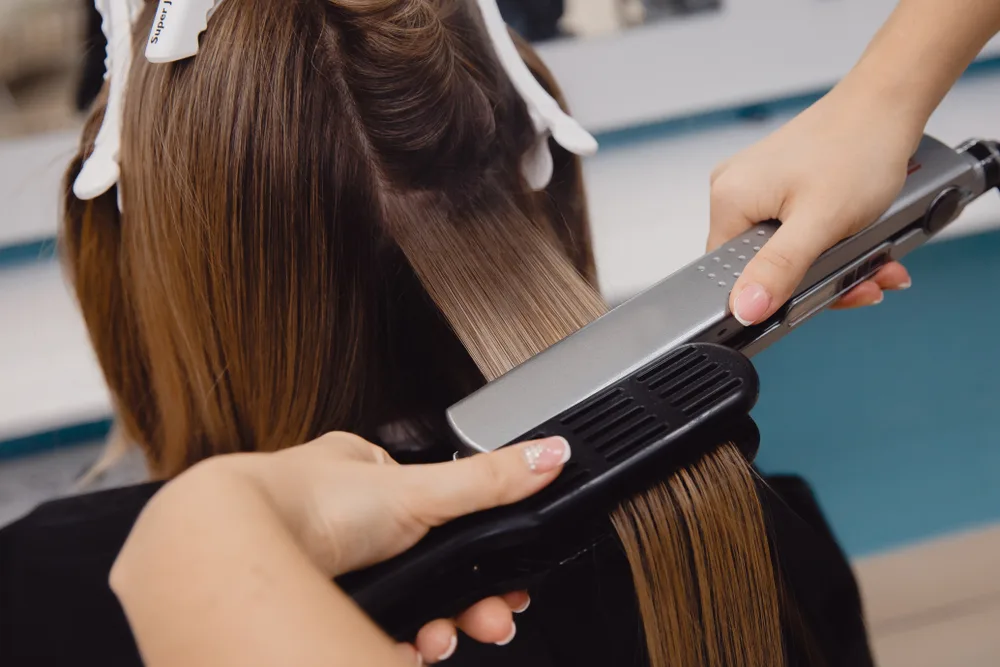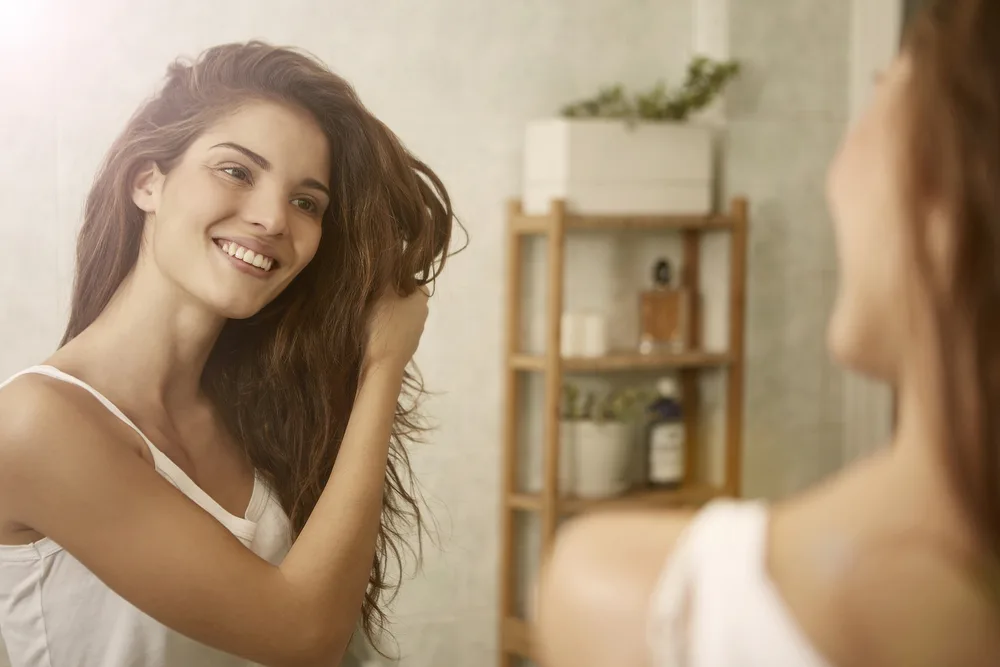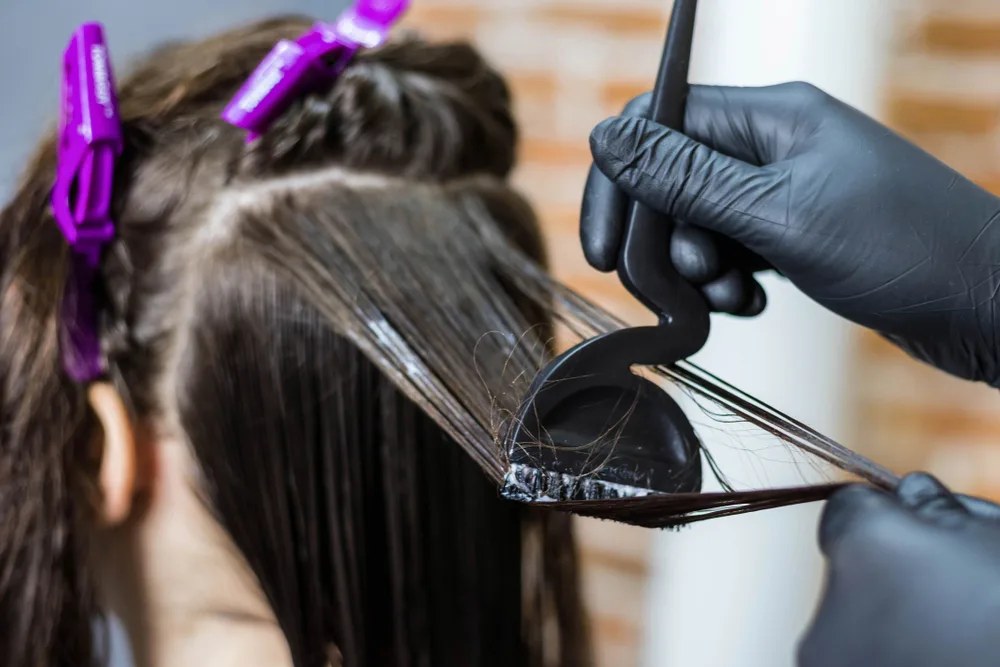Jump to:
Keratin treatments are some of the most popular ways to make your hair look lustrous, smooth, and beautiful. Although keratin is an excellent way to treat your hair, there are some alternatives to keratin treatments that you should consider.
What Is a Keratin Treatment?
While keratin treatments are still prevalent, they are far from the only option in town. Essentially, keratin is a semi-permanent chemical that relaxes your tresses and gives you shiner hair.
Since keratin is chemical-based, people who opt for these treatments are often exposed to several undesirable elements, like formaldehyde. As a result, plenty of people opt for variations on, or alternatives to, keratin treatments.
Why Get a Keratin Treatment
People get keratin treatments to get smoother, shinier hair. Since these treatments mimic a naturally-occurring protein in our hair and nails, keratin treatments can give us the youthful, luxe hair of our younger days.
3 Great Alternatives to Keratin Treatments

Parilov/Shutterstock
There are plenty of alternatives to keratin treatments that yield roughly the same results. If you’re looking for a great way to transform your hair for the better, it’s good to think about both keratin and treatments like keratin.
We’ll guide you through your options to help you make an informed choice and enjoy fantastic, healthy-looking hair in the long run.
1. Tourmaline Hair Smoothing Treatment
Tourmaline hair smoothing treatments are one of the most popular alternatives to keratin treatments, which leave out the formaldehyde, opting for hair-boosting glycolic acid instead.
It’s less harmful to your hair in the long run, and you’ll still get all of the glossy benefits you’d enjoy from a keratin hair treatment.
Another reason why people love tourmaline hair smoothing treatments is that you don’t need to go to a salon to do them. Instead, you can do your own treatment or visit your salon if you really want a professional job.
On the other hand, since it isn’t as chemically potent as keratin treatments, tourmaline hair smoothing treatments tend to last a lot less and can be less effective at straightening hair.
Why Get a Tourmaline Hair Smoothing Treatment
People get tourmaline hair smoothing treatments as an excellent way to make their hair smoother, shinier, and healthy-looking without the chemical additives of your traditional keratin treatment. In addition, since people can do it at home, rather than in the salon, it’s easier and generally less expensive.
2. Brazilian Blowouts
Like keratin treatments, Brazilian blowouts rely on formaldehyde to keep your hair as smooth as possible. As such, it might not be as popular for people who are looking to have fewer chemicals in their lives.
However, Brazilian blowouts are fabulous for straightening your hair and generally take a little less long than keratin treatments.
Why Get a Brazilian Blowout
People get Brazilian blowouts as an alternative to keratin treatments and tourmaline hair smoothing treatments. Since Brazilian blowouts contain a fair bit of formaldehyde, they’re not as natural as tourmaline hair smoothing treatments, but they’re still very popular.
If you get a Brazilian blowout, expect smooth, frizz-free hair, shiny locks, and hair that’s easier to style, at least for the period of time that the blowout is in place.
Read Next: What Happens If You Don’t Rinse Out a Brazilian Blowout?
3. Japanese Hair Straightening
One of the most popular alternatives to keratin treatments, Japanese hair straightening brings the best of many worlds. First, it’s formaldehyde-free, so you won’t have to deal with too many nasty chemical side effects.
Secondly, it works just about as well as a Brazilian blowout or keratin treatment, making it more effective in terms of longevity than the tourmaline hair smoothing treatment.
Although Japanese hair straightening doesn’t rely on formaldehyde, it uses ammonium thioglycolate and sodium hydroxide, meaning it’s not entirely natural. It also happens to be slightly more expensive than some of the alternatives on our list because it’s both permanent and formaldehyde-free.
Why Get a Japanese Hair Straightening Treatment
People get Japanese hair straightening treatments if they want to avoid harsh formaldehyde solutions and if they want permanently straight hair.
However, since it is still a potent treatment, Japanese hair straightening treatments can damage hair slightly, so it’s a good idea to exercise proper hair care before and after your treatment.
These alternatives to keratin treatments are some of the best on the market and can help you have beautiful, frizz-free locks in no time. But, of course, it’s always essential to maintain your hair health before and after hair treatments as well.
You Might Also Like:
- Can You Curl Your Hair After a Keratin Treatment?
- Do Keratin Treatments Cause Hair Loss?
- When You Should Wash Your Hair After a Keratin Treatment
- Is Keratin Good for Low Porosity Hair?
How to Maintain Healthy Hair

Olyy/Shutterstock
Maintaining healthy hair will allow you to look and feel your best between treatments. Everyone’s hair is different, so work with your hair consistency and style to discover the proper routine for your locks.
If your hair is oily, you’ll need to wash it several times a week, but dry hair can get away with far fewer washes. Since washing your hair strips it of moisture, only wash when it’s completely necessary to do so.
Also, ensure you’re washing your scalp correctly, and condition only the bottom parts of your hair. Doing this will make your locks less greasy and frizzy in general.
Also, avoid towel drying your hair. Wet hair is exceptionally fragile, and running a towel over it can cause tons of breakage and damage. Instead, run a wide-tooth comb through your damp locks, allowing your hair to air dry.
Read Next: How to Plop Straight Hair
Eat Well for Good Hair Health
That old adage “you are what you eat” definitely pertains to hair health. Eating a well-balanced, nutritious diet can help your locks look and feel their best.
Try to incorporate plenty of these amazing foods into your diet, and you will heal your hair from the inside out:
- Brazil nuts
- Dark leafy green vegetables
- Almonds
- Tropical fruits
- Water
- Dairy products
- Beans
- Lean proteins
- Fish
You can also take daily multivitamins to ensure that you have all the nutrients you need for healthy-looking hair.
Blow Dry Correctly
Blow drying your hair can break it if you do it incorrectly. Instead, use a low heat setting and move the dryer around constantly to avoid drying or scorching any segments of hair.
If you use heat tools, like blow driers or flat irons, make sure to use a protectant spray on your hair to stave off breakage and damage. Additionally, get your hair cut regularly to eliminate split ends and keep it looking chic instead of straggly.
Frequently Asked Questions

Regina Erofeeva/Shutterstock
These frequently asked questions and their answers will help you determine if a keratin treatment, or these alternatives to keratin treatments, are suitable for you and your hair.
Is keratin good for every type of hair?
Keratin is good for certain types of hair, but they don’t work for everyone. For example, if you have thinner, flatter hair, keratin might have the opposite effect that you’re looking for. On the other hand, if your hair is curly, highly static, or thick, keratin could be right for you. Talk to your stylist.
How do I keep my hair healthy between treatments?
Follow logical steps to keep your hair healthy between treatments, keratin or not. First, shampoo and condition as regularly as your hair needs with a sulfate-free product.
Then, check your bedding. Silk pillowcases do wonders for hair and will help you avoid getting any knots at night. Finally, avoid washing your hair right afterward if you get a keratin treatment or Brazilian blowout.
How often should I do treatments at the salon?
Everyone is different, so it’s essential for you to talk to your haircare professional about how often you should get treatment. Generally speaking, you’ll want to have your treatment every three or four months.
Also, you might notice your hair changing the consistency or getting frizzy. This is a tell-tale sign that you need to go in for a follow-up treatment.
Are there downsides to keratin treatments?
Sometimes, keratin treatments can have some serious and unexpected downsides like irritated eyes, nausea, or headaches. If you experience any of these side effects, it’s essential to stop having your treatments immediately and choose another alternative that’s better for your body.
What alternatives are there to keratin treatments?
Aside from the alternatives outlined here, plenty of conditioners, creams, gels, and shampoos can help you achieve a luxe and smooth look in no time.
If you want to find products that will mimic keratin treatments, consider looking for ones with plenty of amino acids or ceramides. You can also use argan oil or deep conditioners to tame flyaways and give your hair a more balanced and smooth appearance.
So, What Are Alternatives to Keratin Treatments?
There are plenty of alternatives to keratin treatments; you just need to talk to your haircare stylist to find out which one is right for you.
Consider your budget, lifestyle, and hair texture when opting for the proper treatment for you, and don’t be afraid to experiment with different types of treatments if possible.
You can also use a number of different shampoos, conditioners, and treatments to get an excellent effect. There are plenty of options out there. Happy styling!
